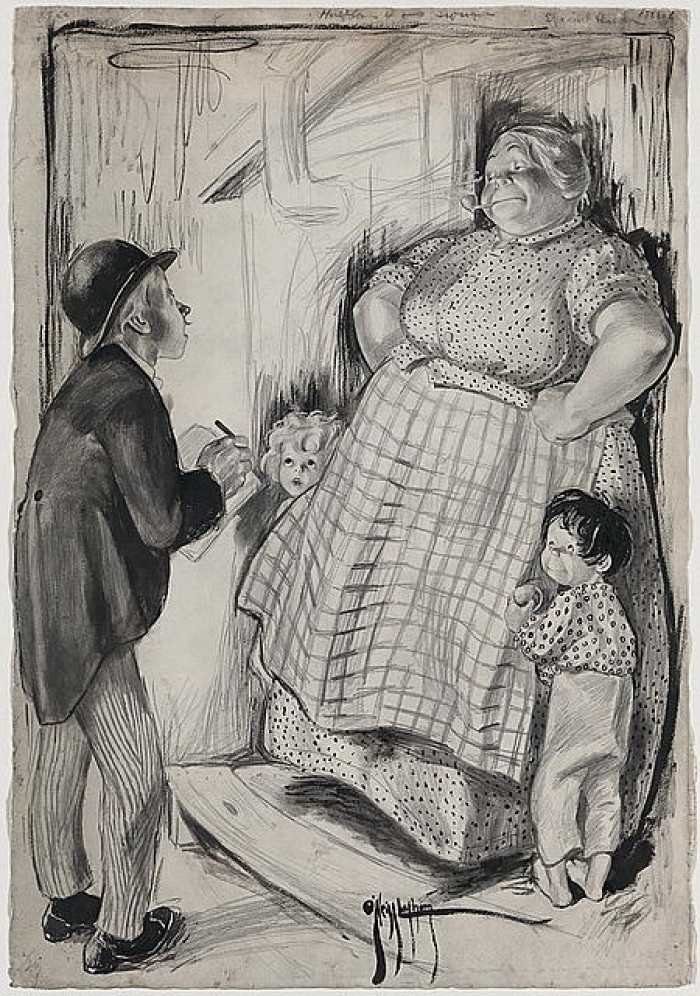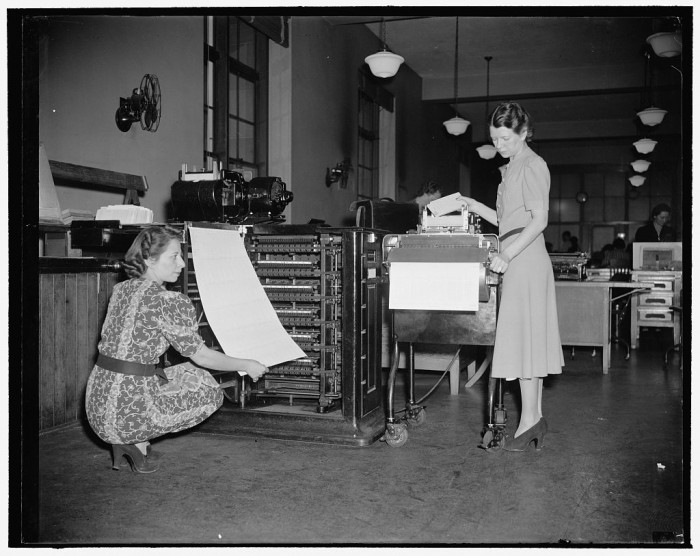House genealogy 101: Discovering home history through census records and property addresses
Utilizing census records and property addresses to learn more about your home's history.
June 6, 2023
(Library of Congress, Census Machine)
Home history research is an exciting journey that can reveal fascinating insights into the past
Whether you're looking to learn more about your family's history or the history of a particular property, the U.S. Census is an essential resource. Conducted every 10 years since 1790, the census provides a wealth of information about individuals and households, including demographic data like age, occupation, marital status, and birthplace. Additionally, unique questions asked on specific census records, such as the 1930 Census question about radio ownership, can provide unique insights into the time period.
While the information contained in census records is invaluable, searching for the right records can be challenging, particularly when researching by property address rather than by name. Fortunately, with the right tools and techniques, it's possible to uncover a wealth of information about a property's history through census records.
In this blog post, we'll outline the steps to search the census by property address and provide examples to illustrate the process. We'll also offer tips for interpreting census records to help you gain a better understanding of the information they contain. By the end of this post, you'll have the knowledge and tools you need to begin your own home history research using the U.S. Census.
A quick summary of the “72-Year Rule” and how the national archives protect information
The United States Census 72-year rule is a federal law that governs the release of personally identifiable information collected during the decennial census. Under this rule, census records are kept confidential for 72 years after they are collected. This means that census records from the 1950 US Census became available on April 1, 2022, hurray! Earlier records are also currently available to the public.
The purpose of the 72-year rule is to protect the privacy of individuals and households that provide information to the census. By keeping this information confidential for 72 years, the Census Bureau can ensure that individuals and their descendants are not negatively impacted by the release of sensitive information. Additionally, the rule allows for more accurate and comprehensive data collection, as individuals may be more willing to provide accurate information knowing it will remain confidential.
Once the 72-year period has passed, census records are released to the public and become valuable resources for genealogical and historical research. Census records provide a snapshot of a particular time period and can offer insights into the lives and experiences of individuals and families. They can also be used to track migration patterns, social and economic changes, and other demographic trends over time.
It's important to note that even after the 72-year period has passed, some information collected by the census may still be restricted due to privacy concerns. For example, the Census Bureau may withhold records that contain sensitive information, such as medical records or financial data, even if the records are more than 72 years old.
Overall, the 72-year rule is a critical component of census data privacy and confidentiality. It allows for the collection of accurate and comprehensive data while protecting the privacy of individuals and households that provide information to the census.
How does the census address relate to the Enumeration District (ED)?
Understanding the Enumeration District (ED) system is key to locating the right Census pages when researching your house history and genealogy. The United States Census Bureau uses EDs as defined geographic areas for the purpose of conducting the decennial census. Each ED is assigned a unique number or letter code that appears on the census records, helping to identify the geographic location of the household or individual being surveyed. The ED system was introduced in the 1880 Census as a way to efficiently collect and process data. By dividing the country into smaller EDs, census takers could more accurately collect data from their assigned areas.
Enumeration books were the physical records used to record the data collected during the census enumeration process. These books were used in the early days of the census, where enumerators would typically record the data by hand in bound books or sheets of paper. Today, enumeration books are important historical documents that provide a valuable resource for genealogical census research and the study of social and demographic trends over time. 
Each enumerator was responsible for a specific area known as an Enumeration District (ED). The boundaries of an ED are typically determined by natural or man-made features such as rivers, highways, and city blocks. During the census enumeration process, the census enumerator would typically begin at one end of the ED and work their way through each household in a systematic manner. The enumerator would ask questions of the head of the household and record the information for every individual living at that address. The enumerator would also make note of any individuals who were temporarily absent, such as those who were away on business or serving in the military.
The information recorded in the enumeration books varied over time and by census year. For example, the questions asked in the 1790 census were limited to the name of the head of household and the number of free white males, free white females, and slaves living in the household. By contrast, the 1940 census asked a wide range of questions about each individual's occupation, income, education, and place of residence five years earlier.
In addition to providing valuable data on individual households, enumeration books also offer a glimpse into the everyday life of Americans at different points in history. For example, the 1930 census included a question about whether a household had a radio set, which sheds light on the increasing popularity and importance of this technology during the early 20th century.
Enumeration books were typically organized in a logical manner, with households arranged by street or neighborhood. However, there were occasional exceptions to this rule. For example, some enumerators might have recorded households in the order that they were visited, rather than by street address. Researchers should be aware of these quirks when using enumeration books for genealogical or historical research.
After the census enumeration was completed, the enumeration books were used to compile the final census report for each Enumeration District. This report included statistical data on the population of the district, including the number of people living there, their ages, genders, races, and occupations. Researchers can use enumeration books to track the movement of individuals and families over time, to learn about their living conditions and occupations, and to gain insights into the social and cultural contexts in which they lived.
Today, EDs are still used in the decennial census and other census-related surveys conducted by the Census Bureau. They are also used in genealogical research as a way to locate and access census records. Understanding EDs and enumeration books can help you efficiently and accurately locate the census records you need to research your house history.
How to find census records by house addresses, an easy way to search the national archives
Let’s dive into how to search the various websites and resources for the U.S. Census data by street address.
Step 1: Determine which census years you’d like to explore. We’ll use searching the 1950s records as our example, but you can use the techniques below to track multiple census collections for your home.
Step 2: Gather the property address information for the census years you are researching. Before you can search for a property address, you need to find and have the correct address information. This can be challenging, especially if you're researching older records, as street names and house numbers may have changed. You can consult old city directories, maps, or plat books to find the correct address.
Step 3: Access online census records for free. Several genealogy websites offer online access to census records where you can find home history, census addresses, and census schedules including Ancestry.com, FamilySearch.org, and HeritageQuest Online which all have access to the national archives.
When conducting research on the history of homes, we've found a straightforward and free method to access the right census pages. Instead of going straight to National Archives, we recommend using the following technique to simplify the process:
Here's how it works:
1) Go to https://stevemorse.org/census/unified.html
2) You’ll select your State, County, City or Town, House Number, and Street
3) This will bring up the 1950 ED numbers corresponding to your location
4) Click “More Details.”
5) This will give you a description of the boundaries of the Enumeration District ("ED")
6) Click on the ED
7) It will ask you to select the viewer you want to use, you can either use the NARA (National Archives) viewer or FamilySearch Viewer for free. Personally, we use the FamilySearch viewer because we think it’s easier to zoom in to see the tiny print.
Step 4: Analyze the results. Once you've found the census record that matches the property address you're researching, it's important to carefully analyze the information. Census records can provide a wealth of information about individuals and households, but it's easy to misinterpret or misread the information. Some things to keep in mind when analyzing census records include the possibility of misspellings, the age of the individual (which may not be accurate), and the presence of other people in the household who may be related.
What happens if no one is home when the census taker comes?
When conducting a census, it is crucial to obtain accurate and complete information about the population to ensure that government resources are distributed equitably and that the population is accurately represented in Congress. However, there are instances where households may not be counted due to a variety of reasons, such as no one being home when the census taker comes. In such cases, the census taker would typically leave a notice asking the household members to fill out the census form and either mail it back or arrange for the census taker to return at a later time.
If the household members were still not available after several attempts, the census taker may try to obtain the information from neighbors or other sources. However, if the household was ultimately not counted, it would be considered a "non-enumerated" household and would not be included in the final census count. This underscores the importance of participating in the census to ensure an accurate count, as it can have significant implications for political representation and resource allocation.
One measure of accuracy in the census is the undercount rate, which refers to the difference between the actual number of people in a population and the number of people counted in the census. In the 1950 census, the undercount rate was estimated to be around 2.2%, which means that approximately 2.2% of the population was not included in the census count. This undercount was mostly due to difficulties in reaching certain populations, such as those living in remote or rural areas, or people who were homeless or transient.
It's important to note that undercounts can have significant implications, particularly for political representation and resource allocation. For example, if a certain group of people is consistently undercounted in the census, they may not receive adequate representation in government or access to resources that are allocated based on population size. In subsequent years, the Census Bureau has taken steps to improve the accuracy of the census count, such as implementing targeted outreach efforts to hard-to-count populations and using new technology to improve data collection and processing. Despite these efforts, however, undercounts still occur, and it's important for researchers and policymakers to be aware of their potential impact when analyzing census data.
Putting on my genealogy hat - compiled property information on the house I grow up in
By learning how to interpret census data, we can gain a deeper understanding of our ancestors' lives and the history of the places we live in. Let's say you're interested in researching the history of a house on 1290 Eleanor Avenue in St. Paul, MN. You find the 1950 Census record for the address, which shows the residents as Peter, Francis, and Clifford Mahlberg.
To interpret this record, you should consider the following:
1) Occupations: Peter Mahlberg's occupation is listed as a fireman. This tells us that he likely worked for the fire department and may have been responsible for fighting fires and responding to emergencies.
2) Age: Peter is listed as 44 years old and Francis is 40 years old. Knowing their ages can give us an idea of their birth years, which can help us locate additional records.
3) Immigration status: It is noted that Peter was from Germany, and his year of immigration to the United States is unknown. This information can be used to trace his family's journey to the United States.
4) Valuation: The house is noted to be valued at around $5,000, which was a more expensive home on the block. This can give us an idea of the socioeconomic status of the family.
5) Household items: It is also noted that the family had a radio. This tells us that they had access to modern technology and were likely interested in news and entertainment.
By considering these factors, we can gain insight into the lives of the Mahlberg family who lived at 1290 Eleanor Avenue in 1950. This information can be used to create a more complete picture of the history of the house and the neighborhood in which it is located.
Additional tips for interpreting Censuses and address search
Interpreting censuses can be challenging, especially if you are not familiar with the historical context or the questions asked in a particular census.
Here are some tips for interpreting censuses:
1) Understand the historical context: Census records are a snapshot of a particular time and place. Understanding the historical context can help you interpret the data correctly. For example, knowing the immigration patterns and social norms of a particular era can help you make sense of the data.
2) Pay attention to handwriting: Census records were usually handwritten, and the handwriting can be difficult to read. If you are having trouble deciphering the handwriting, try looking at other records from the same time period to familiarize yourself with the style of handwriting used.
3) Look for variations in names: People's names were often spelled differently in the past, or they may have used nicknames or middle names instead of their given names. Be aware of these variations when searching for individuals in census records.
4) Look for cross-references: In some census records, individuals may be listed more than once. Look for cross-references between different pages or columns to make sure you are not missing any information.
5) Consider the census taker's bias: Census takers may have had their own biases or assumptions that influenced how they recorded information. For example, they may have made assumptions about a person's race or ethnicity based on their appearance.
6) Use other records to confirm information: Census records should be used in conjunction with other records to confirm information. For example, birth, marriage, and death records can help you confirm relationships and ages.
By keeping these tips in mind, you can more effectively interpret census records and uncover valuable information about your ancestors and the communities in which they lived.
Understanding Census Data - The U.S. Census collects a wide range of data, including information on age, race, gender, income, education, and housing. This data is collected through a variety of methods, such as surveys, questionnaires, and interviews. Census data is available for different geographic areas, including states, counties, cities, and neighborhoods.
To access census data, you can use the U.S. Census Bureau's website, which provides a wide range of data tools and resources. You can also use other data analysis tools, such as social explorer, which provides visualizations and mapping tools for census data.
Types of Analysis - There are different types of analysis that can be done with census data. The descriptive analysis involves summarizing and visualizing data to identify patterns and trends. The inferential analysis involves making predictions or inferences about a population based on sample data. Spatial analysis involves using geographic information to understand patterns in data.
Each type of analysis can provide unique insights into demographic data. For example, descriptive analysis can reveal patterns in income levels across different geographic areas. Inferential analysis can help predict how a population may change in the future. Spatial analysis can reveal patterns in the distribution of different demographic groups.
Additional Tools for Analysis - To analyze census data, you can use a variety of tools and software. Free tools, such as the U.S. Census Bureau's website and social explorer, can provide access to a range of data tools and visualizations. Paid tools, such as ArcGIS and Tableau, offer more advanced data analysis capabilities, such as data visualization, mapping, and statistical analysis.
Evolution of US Census Questions, the archive: 1790 to 1950:
The US Census has evolved over time, and the questions asked have changed as well. Here are some of the various questions that were asked in the US Census from 1790 to 1950:
1790: The first US Census was conducted in 1790 and only asked for the name of the head of the household and the number of people living in the household. The head of the household was required to provide the names of the other household members, but no additional information was collected.
1800-1840: In addition to the name of the head of household and the number of people living in the household, the census began to collect information about the age and gender of household members, as well as data on free white males under the age of 10, free white males aged 10-15, free white males aged 16-25, free white males aged 26-44, free white males aged 45 and over, free white females under the age of 10, free white females aged 10-15, free white females aged 16-25, free white females aged 26-44, and free white females aged 45 and over.
1850: The 1850 census was the first to collect information about all household members, not just the head of household. In addition to the name, age, gender, and race of each household member, the census asked for the occupation of each male over the age of 15, and the value of any real estate owned by the household.
1860-1870: The census continued to collect information about each household member, as well as data on occupation, real estate ownership, and personal estate value. In 1870, the census also began to collect data on the number of children born to each female household member.
1880: The 1880 census added several new questions, including information on the birthplace of each household member, the birthplace of the parents of each household member, and the marital status of each household member.
1890-1920: The census continued to collect information on the same topics as previous years, but added new questions on the number of years a person had been married, the year of immigration and naturalization status of foreign-born individuals, and the ability to speak English.
1930-1950: The census added new questions on employment status, industry and occupation, and income. In 1940, the census added questions on whether the household had a radio, and in 1950, questions on whether the household had a television were added.
Overall, the US Census provides a valuable snapshot of the country and its people at various points in history, and the questions asked reflect the changing social and economic landscape over time. Searching the census by property address can be a valuable tool for genealogy research and finding the history of your houses. By following these steps and tips, you can increase your chances of finding the correct record and interpreting the information accurately. Happy researching, and remember to save your information on HouseNovel to make it easy for the next generation to explore your home's history!

How Renovating Historic Properties Benefits You
Historical properties are society’s tangible assets, which hold significant cultural and economic benefits that need to be preserved for future generations.

From Vacant to Abandoned, the Evolution of Decay
Routine maintenance is required to prevent any property from decaying. When no one is taking care of a property, time, and weather can quickly deteriorate its structural integrity and become a safety threat to the neighborhood.

Not the Up House—But Even Better: Edith Macefield Said No to $1 Million, So They Built a Mall Around Her
You may have heard about the one-bedroom house in Seattle that blocked a mall.

How to Claim a Relative’s Abandoned Property
Any unclaimed property becomes property of the state. So what happens if a relative of yours dies and hasn’t written a will or kept any financial record of it?
